Trees Birds Mammals Fish Amphibians Reptiles
Wild Algarve
Bookshop
Agrocybe rivulosa Nauta - Wrinkled Fieldcap
Phylum: Basidiomycota - Class: Agaricomycetes - Order: Agaricales - Family: Strophariaceae
Distribution - Taxonomic History - Etymology - Identification - Culinary Notes - Reference Sources
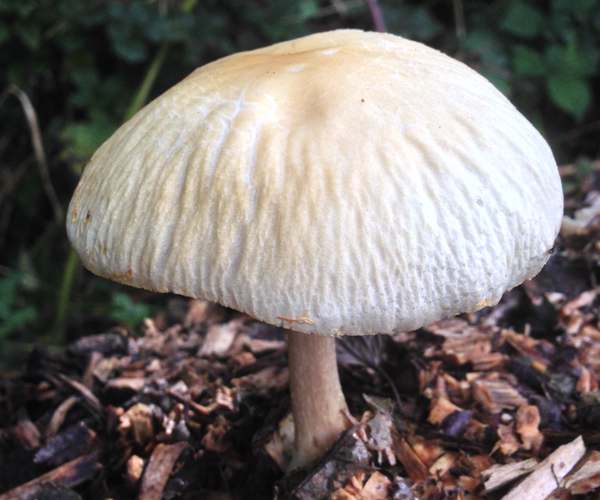
Unknown until 2003 and added to the British list in 2004, this fieldcap has since become fairly common in southern England, where its spread has been entirely due to the practice of mulching flowerbeds using wood chippings. (If it is ever given a common name, that might well have to be the 'Woodchip Fieldcap'.)
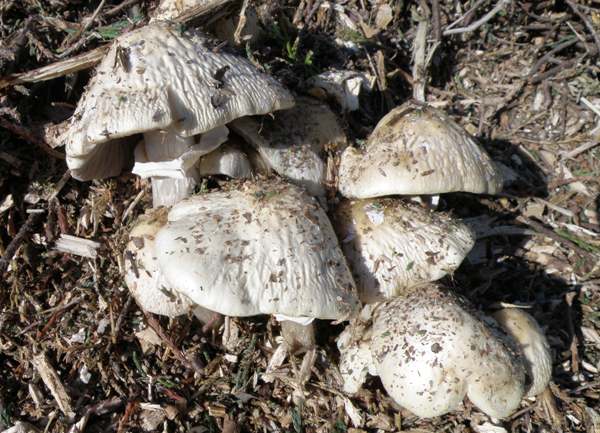
Many other fieldcaps are found on woodchip mulch, but the wrinkled cap of this mushroom is a great aid to its identification.
Distribution
An increasingly frequent find in southern England and in Ireland but also recorded occasionally in Wales and Scotland, where it is most often seen on heaps or on deep layers of woodchip, the Wrinkled Fieldcap occurs also in parts of mainland Europe, notably in Holland where it was first recorded.
Taxonomic history
This species was first recorded and described in 2003 as Agrocybe rivulosa by Dutch mycologist Marijke M. Nauta and published in Persoonia; it does not (yet!) have any synonyms.
Note: In some field guides this mushroom is recorded in the family Bolbitiaceae.
Etymology
Agrocybe rivulosa and a minority of other fieldcap fungi do not occur in open fields; nevertheless, the generic name Agrocybe is derived from Agro-, of fields, and -cybe, head or cap. The specific epithet rivulosa is a reference to the wrinkled grooves that descend like rivulets from the centre of the caps.
Identification guide
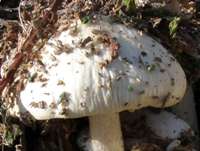 |
Cap
4 to10cm across, hemispherical becoming broadly convex or flat; the pale ochraceous surface develops radial wrinkles linked by a network of cross-veins - hence the common name Wrinkled Fieldcap. |
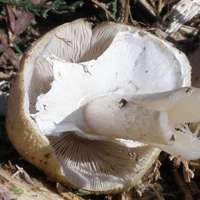 |
Gills
Adnate; initially creamy-grey, turning grey-brown as spores mature.
Stem
5 to 10cm long and 1 to 1.5cm dia.; hollow; tapering slightly towards the apex; white, turning a pale creamy-ochre with age; persistent, thin pendulous stem ring. |
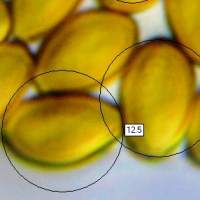 |
Spores
Ellipsoidal, smooth, 11.5-12 x 7-8µm; with a distinct germ pore.
Spore print
Brown. |
Odour/taste |
Not distinctive |
Habitat & Ecological role |
Saprobic, on large groups or tufts on woodchip piles and on deeply-mulched flowerbeds. |
Season |
June to October in Britain and Ireland. |
Similar species |
Agrocybe praecox, which occurs in
spring and early summer, often grows in woodchip mulch; it is typically smaller and usually has a darker cap. |
Culinary Notes
The Wrinkled Fieldcap Agrocybe rivulosa is still fairly rare and it is not generally reported to be edible, although there is at least one report of it being eaten with no discernible adverse effects. (A close relative, the Poplar Fieldcap Agrocybe cylindracea, is considered a good edible mushroom.) We cannot conform that this mushroom is safe and good to eat in the long term or that it does not upset some people's stomachs, and so do not recommend gathering and eating it.
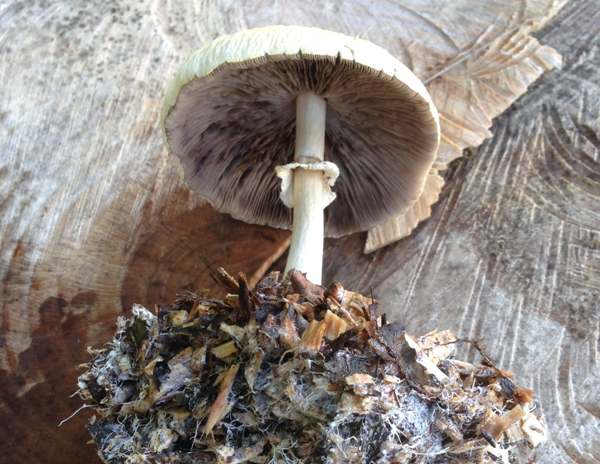
Reference Sources
Fascinated by Fungi, 2nd Edition, Pat O'Reilly 2016, reprinted by Coch-y-bonddu Books in 2022.
Nauta, M.M. 2003. A new Agrocybe on woodchips in northwestern Europe. Persoonia 18(2): 270-274
BMS List of English Names for Fungi
Dictionary of the Fungi; Paul M. Kirk, Paul F. Cannon, David W. Minter and J. A. Stalpers; CABI, 2008
Taxonomic history and synonym information on these pages is drawn from many sources but in particular from the British Mycological Society's GB Checklist of Fungi.
Acknowledgements
This page includes pictures kindly contributed by Simon Harding.
Top of page...
Fascinated by Fungi. Back by popular demand, Pat O'Reilly's best-selling 450-page hardback book is available now. The latest second edition was republished with a sparkling new cover design in September 2022 by Coch-y-Bonddu Books. Full details and copies are available from the publisher's online bookshop...